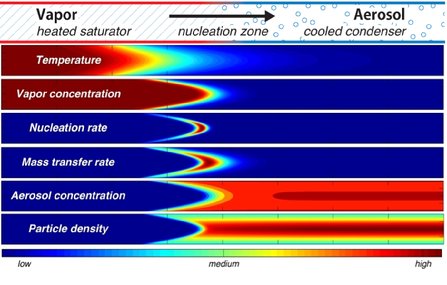Multi-scale modeling and simulations of aerosol nucleation and transport in porous media
Organization:
Funded by: | Philip Morris Products S.A |
PhD: | Edo Frederix |
Supervisor: | Prof. Bernard Geurts |
Collaboration: | Philip Morris Products S.A. |
Description:
Typically, the process of species nucleation and condensation is governed by an array of time scales. For example, the formation of embryo sites is very rapid, while diffusion of mass or heat is considerably slower, up to orders of magnitude. However, both processes are important, in the sense that they have a strong influence on the end result. This poses a multi-scale character of the problem.
In this PhD project, we investigate the complex physics of the aerosol creation in a tobacco plug, using a numerical approach. We aim at developing and implementing an accurate model for the multi-species nucleation in porous media, while incorporating the multi-scale character of the flow in a computationally efficient and accurate way. This knowledge is needed to understand the functioning of heated tobacco products that might reduce the health effects of smoking.
Schematically the process of aerosol formation is depicted in the figures below, showing simulations of the laminar flow diffusion chamber (see poster [1]). The hot vapor is cooled down and simultaneously the nucleation happens next to condensation and evaporation processes that lead to aerosol generation (mass transfer from gas to liquid) with certain physical characteristics (particle number density, particle size). The multi-species mixtures and naturally intricate and subtle geometrical and thermal conditions raise additional challenges in this project.
The research described in this text is supported by Philip Morris Products S.A. and the author wishes to thank Philip Morris Products S.A. for their financial support.
Publications:
Pictures:
| |

